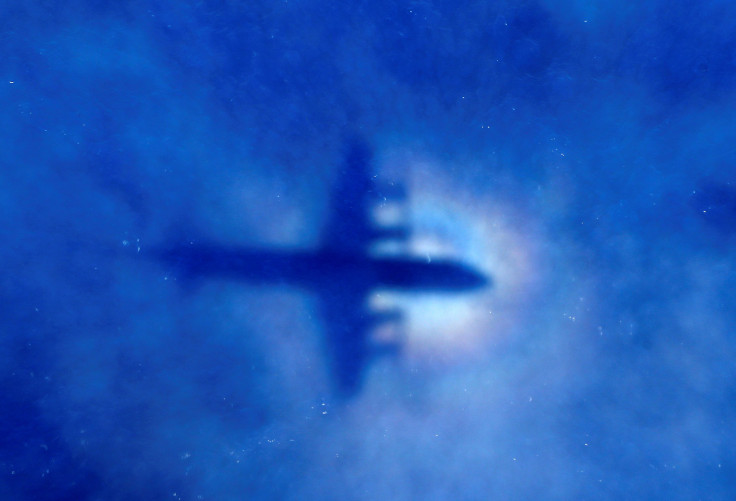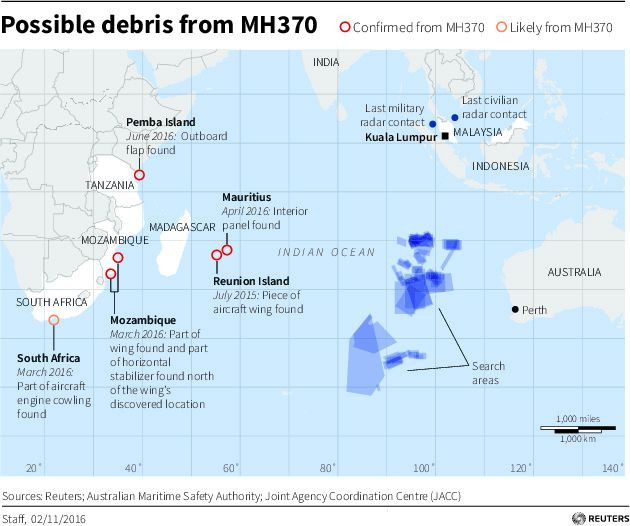Is The Flight MH370 Search Over? 8 Facts About The Missing Malaysian Plane

Three years after Malaysia Airlines Flight 370 disappeared during a trip from Kuala Lumpur to China, the international search effort for the plane has ended. As families of the 239 passengers and crewmembers on board have vowed to press on through a private campaign, International Business Times has gathered some interesting facts about the largest air-sea search in history.
1. The search for MH370 covered a space about the size of Pennsylvania.
The search for the missing plane encompassed more than 46,000 square miles across the southern stretch of the Indian Ocean, about 772 miles off the coast of Perth, Australia. The search briefly covered nearly 3 million square miles or 1.5 percent of the Earth's surface a week after the crash before satellite data refined the scope of the investigation.
2. It was also likely the most expensive search in history.
The total cost of the search was around $200 million. Australia has contributed nearly half of the bill, having spent $90 million on the operation. China reportedly provided an additional $20 million, with Malaysia pledging to balance the costs by spending at least $120 billion, according to Australia's Joint Agency Coordination Center.

3. At its height, the search involved 26 nations.
At the peak of the search, at least 43 ships and 58 aircraft were deployed by Australia, Bangladesh, Brunei, China, France, India, Indonesia, Japan, Kazakhstan, Kyrgyzstan, Laos, Malaysia, Myanmar, New Zealand, Pakistan, Philippines, Russia, Singapore, South Korea, Thailand, Turkmenistan, the United Arab Emirates, the U.K., the U.S., Uzbekistan and Vietnam.
4. The missing passengers and crew came from 14 countries.
More than half of those aboard, 153, were Chinese citizens. All 12 crewmembers plus 38 passengers were Malaysian. There were also seven passengers from Indonesia, six from Australia, five from India, four from France, three from the U.S., two from Canada, two from New Zealand, two from Ukraine, one from the Netherlands, one from Russia, one from Taiwan and two Iranians traveling under false Italian and Austrian passports.
5. The two Iranians were believed to be traveling to Europe to seek asylum.
Initially, suspicion befell the pair when it was revealed they had traveled under fake documents. However, the investigation revealed no links to terrorism and family ties to Europe where they reportedly had hoped to spend their lives.

6. The underwater search did not yield anything.
Despite the massive effort, no debris was discovered in the water. Early evidence of underwater "pings" being sent from what was suspected to be the aircraft's surviving electronics were later proved mistaken. About 20 pieces of wreckage potentially belonging to the plane, however, have since been discovered by citizens on the shores of Africa and the various islands of the Indian Ocean.
7. Conspiracy theorists have taken great interest in the event.
The unprecedented scale of the search effort and the lack of any conclusive evidence has attracted a wide range of theories over what happened. While the more reliable theories have surfaced around a cockpit fire or a number of mechanical failures that would have led the captain to divert from the planned route to Beijing in an attempt to land at the Malaysian airstrip in Pulau Langkawi before ultimately plunging into the ocean. Others have insisted a hijacking occurred at the hands of Russia or militants of the Islamic State group, also known as ISIS. Some also theorized a regional military or the U.S. shot it down by accident.
8. Four months later, the same airline and aircraft type were involved in an even deadlier incident.
As Malaysia Airlines, the nation's flag carrier, struggled to explain the mysterious disappearances MH370, another of its Boeing 777-200ER vanished from its radars. This time, the aircraft was shot down over the skies of war-torn Ukraine. Both sides of the conflict, the Ukrainian military and separatist rebels sponsored by Russia blamed each other for the incident.
© Copyright IBTimes 2024. All rights reserved.






















